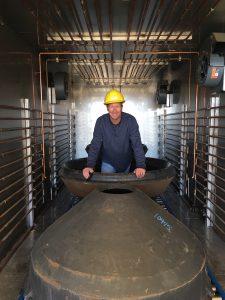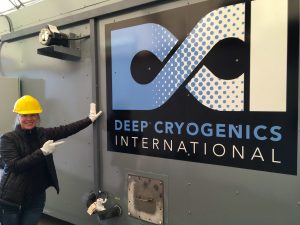Jack Cahn
Deep Cryogenic International
Deep Cryogenic Treatment-The Story Behind It
 Today we are speaking with Mr. Jack Cahn, owner and Founder of Deep Cryogenic International, a fascinating heat treatment process pioneered by Jack himself. “Jack, I will be very upfront and say I know little about cryogenics, as a matter of fact it has always seemed to me to be a contradiction in terms that a sub zero process can even be considered a heat treat process. So for the sake of my education and perhaps some others in the industry could you please give us a brief summary about the cryogenic process?”
Today we are speaking with Mr. Jack Cahn, owner and Founder of Deep Cryogenic International, a fascinating heat treatment process pioneered by Jack himself. “Jack, I will be very upfront and say I know little about cryogenics, as a matter of fact it has always seemed to me to be a contradiction in terms that a sub zero process can even be considered a heat treat process. So for the sake of my education and perhaps some others in the industry could you please give us a brief summary about the cryogenic process?”
“Sure. Deep cryogenic treatment (DCT) is a -300°F (—190ºC) cold treatment that increases wear resistance and yield strength in most steel alloys from 20-70%. DCT also increases the conductivity of copper, lowers corrosion rates and significantly shrinks the heat affected zone of welds and additive manufactured items. The process is permanent, takes 2 days to complete, doesn’t change dimensional size and costs under $1.00 per pound to treat an item. The process is non-toxic, uses no chemicals and generates no environmental waste. DCT usually follows heat treatment and requires 1-2 tempering steps to eliminate hydrogen embrittlement and restore ductility. Think of it as the completing the circle of thermal treatment – going from high to low temp and then back to ambient to optimize wear and durability.”
The next logical question would be, how prevalent is cryogenics amongst captive and commercial heat treaters? Is this a well-known process?
“There are about 200 heat treaters in North America that have cryogenic chambers though most perform cold treatment and shallow cryogenics (-70°F to -240°F) to reduce retained austenite after martensitic transformation. DCT is generally accepted by heat treaters to reduce retained austenite in tool steels but it has not yet become a ‘go to’ process to address mechanical wear. It is inexpensive to provide DCT and easy to load as no fixturing is required. You can often batch load different geometries and alloys in the same run. Deep cryogenics is one of the highest profit thermal processes available to a heat treat operation.”
Then why isn’t the process more common than it is?
“Generally, it’s lack of industry awareness. Until recently, no industrial-size DCT equipment, ASTM-recognized test methods or any 3rd party qualification have been available. Both heat treating and deep cryogenics are thermal treatments but while heat treating is 10,000 years old, liquid nitrogen production and DCT have been around for only 100 years. This lack of familiarity has been a challenge and heat treaters, like most of us, generally are more comfortable with what we already know. Now that industrial customers are seeing clear evidence that DCT improves both wear item life and bottom line profit, I expect heat treaters to take another look at deep cryogenics.”
 Let’s now take a step back and look at yourself and “Deep Cryogenics International”. What is your background and how did you ever come to start the company?
Let’s now take a step back and look at yourself and “Deep Cryogenics International”. What is your background and how did you ever come to start the company?
“I first discovered cryogenics in the late 1990’s when operating a 35 person, precision machine shop in the US – doing work for Jet Propulsion Lab and Lockheed. We were machining mostly nickel, kovar and titanium that burned through tooling. I wanted to reduce the high cost and wear on small endmills and drills. A friend introduced me to cryogenics and I found the process almost doubled my tooling life. More CNC spindle uptime, less labor spent changing tools, more production output. As an end user, it was a no brainer and I used DCT extensively. Later, I considered how it could improve the wear life of the items I machined for my customers. So I went into business with my wife Linda and we spent years writing research papers, developing treatment recipes and understanding the science. But no one ran a test lab, promoted the technology or conceived of scaling-up DCT equipment to reach industrial customers. So we acquired test equipment, began building large DCT chambers and opened our business in Nova Scotia in 2018. We will open a demonstration center in Alberta in June.”
You offer both the equipment, research and if I understand correctly you can provide cryogenic treatments. What is the focus of most of your attention? I will rephrase that and ask which of these services takes up most of your time?
“We do provide DCT but most of our effort is focused on building and leasing large DCT equipment and providing R&D testing for future and present customers. Besides leasing our smaller vacuum-insulated round chambers, we build the largest DCT equipment in the world. At 8’ x 8’ x 20’ with a 45,000 treatment capacity, it is the DCT equivalent of a car-bottom furnace and is the only industrial size equipment available on the market. We support all our customer leases by providing R&D, process optimization and testing – included with the lease. Although we perform metallurgical testing and microscopy, our R&D lab is primarily for applied research. We have XRD, white light interferometry and one of the only ASTM G81 gouging abrasion testers in existence in North America. We keep pretty busy.”
 In an earlier conversation you mentioned that you offer the equipment on a lease basis, as a matter of fact we recently had a press release about a heat treater in Colorado who leased a system from you. When we discussed this previously you asked me if this was common practice in our industry-my answer was that in our field leasing is very unusual. The reason being is that heat treat equipment is typically reasonably large, generally has a large install cost and of course starts self destructing the second it is put into service. Why do you think that your systems would be any different?
In an earlier conversation you mentioned that you offer the equipment on a lease basis, as a matter of fact we recently had a press release about a heat treater in Colorado who leased a system from you. When we discussed this previously you asked me if this was common practice in our industry-my answer was that in our field leasing is very unusual. The reason being is that heat treat equipment is typically reasonably large, generally has a large install cost and of course starts self destructing the second it is put into service. Why do you think that your systems would be any different?
“DCT equipment life is entirely different because high heat erosion never impacts or affects cryogenic equipment. Our small chambers take 2 hours to install before they can operate and they can last 20+ years – operating at near-new efficiencies during the equipment life. All our machines temper as well as DCT – cycling from -300°F to 300°F to complete the process without requiring a separate tempering furnace. Although we will sell DCT equipment, in order to promote this technology we are prepared to share the expense of technology adoption with our customers by offering a leasing option.”
“We have also developed a complete industrial-size platform for lease to heat treaters that want to produce liquid nitrogen on-site from the air that we breath and use it for DCT as well as for other heat treat operations. This is a breakthrough innovation because now heat treaters don’t have to wait on high cost deliveries of bulk LN2 from gas suppliers – they can produce it on site from 240 -1,000 litres per day. Our platform includes our 36K DCT chamber, a liquid nitrogen generator, scroll air compressor, chiller and all the peripherals. We will demo this platform at our Alberta facility and provide customers full onsite installation, training and post-leasing support.”
 Jack, you have invested a lot of time, money and effort into this project which tells me you feel strongly that there is a large market out there-how large do you think the potential market is? As an example do you feel every commercial heat treater out there should be interested in this technology? Or are there just a few very specific areas where this technology is a “no brainer”?
Jack, you have invested a lot of time, money and effort into this project which tells me you feel strongly that there is a large market out there-how large do you think the potential market is? As an example do you feel every commercial heat treater out there should be interested in this technology? Or are there just a few very specific areas where this technology is a “no brainer”?
“Historically, cryogenics has been a quirky but small market process used primarily in motor sports, firearms and machine shops. But the market is really in mining, power generation, transportation and road construction – places where abrasive wear creates high cost, lots of downtime and limits productivity. We are seeing lots of pushback against DCT from OEM’s of cast, forged and machined wear items due to DCT’s impact on their consumable sales – that’s how we know that we struck a nerve. Heat treaters respond directly to the market. It won’t be long before end users of high wear items seek out heat treaters for DCT of large parts or economy-of scale capacity to support their needs. Heat treaters will see DCT demand coming from end users, not just from manufacturers.”
When you approach a potential customer with your technology what is a typical response? A blank stare saying what are you talking about? An enthusiastic question about why haven’t you approached me before? Another way to phrase this question would be to ask how much does the typical heat treater know about cryogenics?
“Most have heard of the technology but usually not a lot more. New technologies require awareness, understanding and often field demonstrations – usually prior to adoption. These discussions take time and a collaborative effort. That’s why we decided to open our demo center. We bridge the knowledge gap by performing DCT, conducting lab or field testing and helping a customer ‘kick the tires’ by seeing the improvement with their own eyes.”
This interview would not be complete without talking about where you are located. You told me how you are located in the wilds of Alberta, Canada where wildlife is more prevalent than people-I leave it up to you to take it from there.
“Linda and I live in a log cabin in Twin Butte – surrounded by moose, Saskatoon berries and mountains that seem to rise out of the prairie. It is a very conscious and present choice. The ranch nearby runs cattle that provide an endless source of barking for our golden retriever. We have some very good friends there and beneath all those friendships is an awareness of where and how we all chose to live. Although it is only 15 minutes to our facility in Pincher Creek, it feels like another world.”
You are obviously very passionate and knowledgeable about your products, I wish you the very best of luck in the future. I have already made myself a note to touch base with you in the next few months to see how your projects are going, I and many others look forward to hearing about how the industry embraces your ideas.

